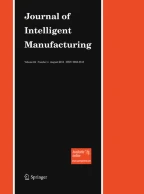Abstract
A combined deep drawing–extrusion process is modeled with artificial neural networks (ANN’s). The process is used for manufacturing synchronizer rings and it combines sheet and bulk metal forming processes. Input–output data relevant to the process was collected. The inputs represent geometrical parameters of the synchronizer ring and the outputs are the total equivalent plastic strain (TEPS), contact ratio and forming force. This data is used to train the ANN which approximates the input-output relation well and therefore can be relied on in predicting the process input parameters that will result in desired outputs provided by the designer. The complex method constrained optimization is applied to the ANN model to find the inputs or geometrical parameters that will produce the desired or optimum values of TEPS, contact ratio and forming force. This information will be very hard to obtain by just looking at the available historical input–output data. Therefore, the presented technique is very useful for selection of process design parameters to obtain desired product properties.
Similar content being viewed by others
References
Ashhab M. S. (2008) Optimization and modeling of a photovoltaic solar integrated system by neural networks. Energy Conversion and Management 49(11): 3349–3355
Chiang Y., Chang L., Chang F. (2004) Comparison of static-feedforward and dynamic- feedback neural networks for rainfall–runoff modeling. Journal of Hydrology 290(3–4): 297–311
Haykin S. (1998) Neural networks: A comprehensive foundation. Prentice-Hall, Englewood Cliffs, NJ
Huang W., Kovacevic R. (2011) A neural network and multiple regression method for the characterization of the depth of weld penetration in laser welding based on acoustic signatures. Journal of Intelligent Manufacturing 22(2): 131–143
Jeguirim S. E., Dhouib A. B., Sahnoun M., Cheikhrouhou M., Schacher L., Adolphe D. (2011) The use of fuzzy logic and neural networks models for sensory properties prediction from process and structure parameters of knitted fabrics. Journal of Intelligent Manufacturing 22(6): 873–884
Johnston A. B., Maguireb L. P., McGinnity T. M. (2009) Downstream performance prediction for a manufacturing system using neural networks and six-sigma improvement techniques. Robotics and Computer-Integrated Manufacturing 25(3): 513–521
Makarynskyy O. (2004) Improving wave predictions with artificial neural networks. Ocean Engineering 31(5–6): 709–724
Merklein, M., Koch, J., Schneider, T., & Oppelt, S. (2010). Manufacturing of complex functional components with variants by using a new metal forming process—sheet-bulk metal forming. In Proceedings of conference on material forming, ESAFORM, Brescia.
Mungiole M., Keith Wilson D. (2006) Prediction of outdoor sound transmission loss with an artificial neural network. Applied Acoustics 67(4): 324–345
Patterson D. (1990) Introduction to artificial intelligence and expert systems. Prentice-Hall, Englewood Cliffs, NJ
Quintana G., Garcia-Romeu M. L., Ciurana J. (2011) Surface roughness monitoring application based on artificial neural networks for ball-end milling operations. Journal of Intelligent Manufacturing 22(4): 607–617
Radha Ramanan T., Sridharan R., Shashikant K. S., Noorul Haq A. (2011) An artificial neural network based heuristic for flow shop scheduling problems. Journal of Intelligent Manufacturing 22(2): 279–288
Reddy K., Ranjan M. (2003) Solar resource estimation using artificial neural networks and comparison with other correlation models. Energy Conversion and Management 44(15): 2519–2530
Reklaitis G. (2002) Engineering optimization. Wiley, New York
Röhner, S., Breitsprecher, T., & Wartzack, S. (2011). Acquisition of design-relevant knowledge within the development of sheet-bulk metal forming. In: Proceedings of the 18th international conference on engineering design, Kopenhagen, Denmark.
Tian Z. (2012) An artificial neural network method for remaining useful life prediction of equipment subject to condition monitoring. Journal of Intelligent Manufacturing 23(2): 227–237
Vandegriff J., Wagstaff K., Ho G., Plauger J. (2005) Forecasting space weather: Predicting interplanetary shocks using neural networks. Advances in Space Research 36(12): 2323–2327
Wang Q. (2007) Artificial neural networks as cost engineering methods in a collaborative manufacturing environment. International Journal of Production Economics 109(1–2): 53–64
Author information
Authors and Affiliations
Corresponding author
Rights and permissions
About this article
Cite this article
Ashhab, M.S., Breitsprecher, T. & Wartzack, S. Neural network based modeling and optimization of deep drawing – extrusion combined process. J Intell Manuf 25, 77–84 (2014). https://doi.org/10.1007/s10845-012-0676-z
Received:
Accepted:
Published:
Issue Date:
DOI: https://doi.org/10.1007/s10845-012-0676-z
